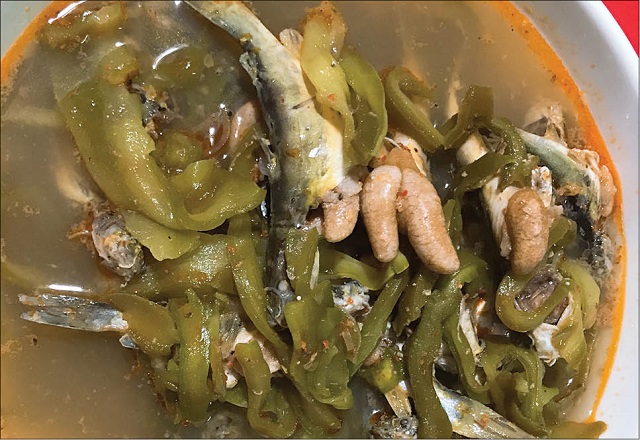
Cranoglanis in cactus soup – a fresh delight in the springtime.
While his brother took the fish off the net, to my surprise, my husband quickly rushed to a nearby sand dune and returned with a basket full of cactus. My mother-in-law cried in delight “What a blend! Cranoglanis and cactus make a perfect match!”
She then went on to prepare the cactus. Picked cactus was cut into pieces, skin-peeled, then thinly sliced along the edge to leave out the core. The chopped cactus was then marinated with raw salt to reduce slime, then tightly squeezed to remove water, washed, and squeezed again till dry. Fresh cranoglanis was cleaned, seasoned, and let sit for about 20 minutes.
Surprised and excited with the strange dish, I was also thrilled to taste it with mom. After marinating, she fried minced onion with oil and chili powder in a pan to arouse smell. She added cranoglanis and stirred it well before filling the pan with cactus, then poured some cold boiled water. We waited till the fish was fully cooked, then turned off the stove.
The whole family gathered around the tray full of delicious city-made dishes, but the fabulous rural hot soup of cranoglanis and cactus was far more popular. While enjoying, my husband and dad recalled tales of the old days.
For coastal villagers, growing vegetables is a challenge since the sand can only be home to cactus - a kind of "vegetable" substitute for regular meals. Especially in the dry season, a bowl of cactus soup with freshly caught sea fish can be truly invigorating. Yet the cranoglanis caught in lagoon still makes the best ingredient for the soup.
At first, cactus in the soup did not impress me with any of its distinct flavors, but the more I chewed, the crunchier it became, alongside with its chewy and mild sour taste. Cactus is slightly sour with a milder flavor than starfruit and lemon and can reduce any fishy taste. It is thus can be suitably used for many kinds of fish, sea and freshwater fish alike.
I had the chance to try quite a few strange dishes since becoming daughter-in-law in a rural coastal family. Yet it never dawned on me how cactus could go with cranoglanis in a soup when this spiny plant makes a fabulously succulent vegetable. Its flavor reflects the soul of the coastal villagers and indeed, raises generations after generations in the arid sandy soil.
On the very first days of spring, I sensed love and sincerity within our sad and fun stories, within the hearts and souls of the coastal people when we all gathered around the family meals with a bowl of cactus hot soup, enjoyed it with hearty laughs.
Story and photo: THAO VY